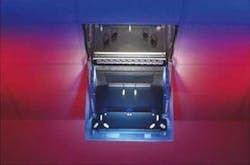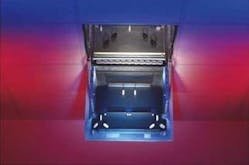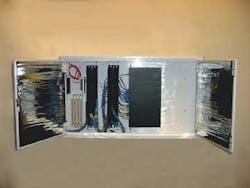Interested in reducing costs and downtime while increasing performance and bandwidth? Implementing zone cabling with backbone cable from the telecommunications room (TR) to active equipment housed in telecommunications enclosures (TE), and short runs of copper to the workstation, may be the answer. TEs act as a mini TR, providing consolidation, distribution, and point of termination out in the work area.
The current TIA/EIA-569B Pathways and Spaces draft standard includes specifications for TEs and the distribution of active network electronics near the work area. Although the standard will not be approved and published until at least mid-year, already installers are implementing zone cabling for their clients, and several types of TEs are available from industry manufacturers (see [download] table). {pdf size=452k}
Over head and under foot
TEs designed to mount into a drop ceiling tile grid, or into raised floors, free up valuable space in an open office environment. American Access Technologies' (www.aatk.com) A1222-HR enclosure mounts in a 2-ft × 2-ft ceiling tile, and houses standard 19-inch rack-mountable hardware with up to 2 rack units (RUs) for active electronics and 5 RUs for any combination of passive connectivity.
"We're seeing a dramatic increase in the popularity of TEs, and the demand is coming from the end user," says Will Boyd, vice president of sales for American Access Technologies. "With zone cabling and TEs, MAC downtime only affects the users connected to the zone experiencing the change." American Access Technologies also offers a 2-ft × 4-ft ceiling TE, and 2-ft × 2-ft raised-floor TEs available with up to 11 RUs of space.
Tyco Electronics/AMP Netconnect (www.ampnetconnect.com), pioneers in zone cabling technology, offers an in-ceiling consolidation point enclosure with 2 RUs for active electronics and 5 RUs for passive connectivity. AMP Netconnect's raised-floor TEs are available with a capacity of 4, 8, or 11 RUs, depending on floor height. "All AMP Netconnect enclosures capable of housing active electronics include an internal cooling fan," says Brian Davis, product manager.
null
Corning Cable Systems' (www.corningcom) Active Zone Box mounts in a 2-ft × 2-ft ceiling tile and provides up to 5 RUs of equipment mounting space. "When you extend fiber deeper into the horizontal with zone cabling, the zones can offer a 50% better network performance for horizontal systems operating at 100 Mbits/sec compared to tradition copper homerun architecture," says Doug Coleman, Corning technology and standards manager. "This will be especially important as new computers are being provisioned with
1-Gig network interface cards." The Active Zone Box is available with grounding, lock, or cable entry kits. Corning Cable Systems' 12.5-inch high Active Floor Box for raised floor LAN environments provides 5 RUs for passive equipment and 2 RUs for active.
Hubbell Premise Wiring's (www.hubbell-premise.com) ZOBOX zone boxes are available for access floor and in-ceiling applications. "Most manufacturers are offering ceiling and floor TEs because they want to provide customers with a full range of solutions," says Robert Baxter, Hubbell's director of datacom marketing. Hubbell's ceiling box accommodates active equipment that will fit in a 2 RU space, while the floor box is designed with a capacity of up to 8 RUs for passive equipment. "The advantage of the ceiling box is that it's flexible, convenient, and out of the way," says Baxter.
Panduit (www.panduit.com) currently offers PanZone in-ceiling and in-floor enclosures for housing 110 wire blocks, patch panels, and other passive equipment. In the coming months, Panduit will introduce active equipment enclosures to keep up with the trend of extending fiber into the horizontal. "We're getting requests from our customer base for active TEs, and we're working on developing enclosures that meet all of the UL and TIA/EIA standards," says Kevin Honan, Panduit's product development manager.
Hang it on the wall
"The main differences in wall-mount telecom enclosures are the type of insulation used to reduce noise and the degree of security," says Davis of Tyco Electronics/AMP Netconnect. Early this year, the company says, it will introduce a wall-mount active equipment enclosure targeted for the education market. The enclosure will provide 4 RUs for passive equipment and 2 RUs for active, as well as an integrated optical-fiber entry point. "By integrating the fiber housing into the cabinet, the incoming fiber does not take up the rack space needed for other passive equipment," explains Davis. "We've also made the new cabinet highly secure, because in a school environment, anything that can be opened will be opened." The enclosure also includes space for 110 wiring blocks.
null
Holocom Networks (www.holocomnetworks.com) offers both a vertical- and horizontal-oriented Commercial Active Gateway—a durable wall-mount TE that accommodates up to two 48-port 19-inch patch panels, and provides 3 RUs for active equipment. Holocom Networks' N-Wall Solution mounts into the wall between steel studs.
"I was showing our wall-mount enclosure around, and people started to ask if they could flush-mount it into the wall. That's when I came up with the idea of the N-Wall," says McAllister. "It's a great solution for environments where they need a less-obtrusive TE. It also offers the benefit of accepting interior wall cabling."
null
Hubbell's REBOX remote equipment cabinet is designed to house remote passive and active equipment in hostile, insecure environments. "The REBOX doesn't just push the elements of the TR closer to the work area; it also provides a secure environment that protects against vandalism, dust, and temperature," says Baxter. Used widely in classroom environments, the REBOX provides up to 9 RUs—five for active equipment and four for passive. Kits for power, fan, sound dampening, and for joining cabinets side-by-side or top-to-bottom are available. Hubbell also offers a larger QuadCab wall-mount cabinet with a 250-pound load capacity and up to 26 RUs—designed especially for warehouses or other remote areas.
Not your typical cubicle
Another option is to install TEs into open-office furniture wall panels. As part of its LANscape solutions product line, Corning Cable Systems offers a new Active Wall System with space for a 1U switch and patch panels. The Active Wall System is designed for use with the popular EthoSpace cubicle furniture manufactured by Herman Miller. "With this system, you can locate the TE anywhere on an office floor," says Coleman. "It can provide better access and greater bandwidth due to even shorter copper links."
Holocom Networks' Secure Infrastructure Solutions consists of a wall-mount TE that provides up to 3 RUs for active equipment; TopRunners that safely route cable along the top of the furniture; and movable, lockable enclosures that mount to non-acoustic furniture panels or desktops.
In addition to using TEs for zone cabling, manufacturers are also experiencing an increased demand for wireless enclosures. "More and more people are using wireless zones as a supplement to their networks," says Holocom's McAllister. "It's a great alternative in common areas where users are just trying to share information, and they don't need high speeds and security."
Coleman says it may be a slow migration for zone cabling to become commonplace. "A lot of people are reluctant to do anything that's not a standard," says Coleman. "The key will be education. "Eventually, everyone will realize the benefits and move towards using TEs to implement zone cabling, especially with TIA/EIA recognizing it in the upcoming revised 569B standard.
Betsy Ziobron is a freelance writer covering the cabling industry.



